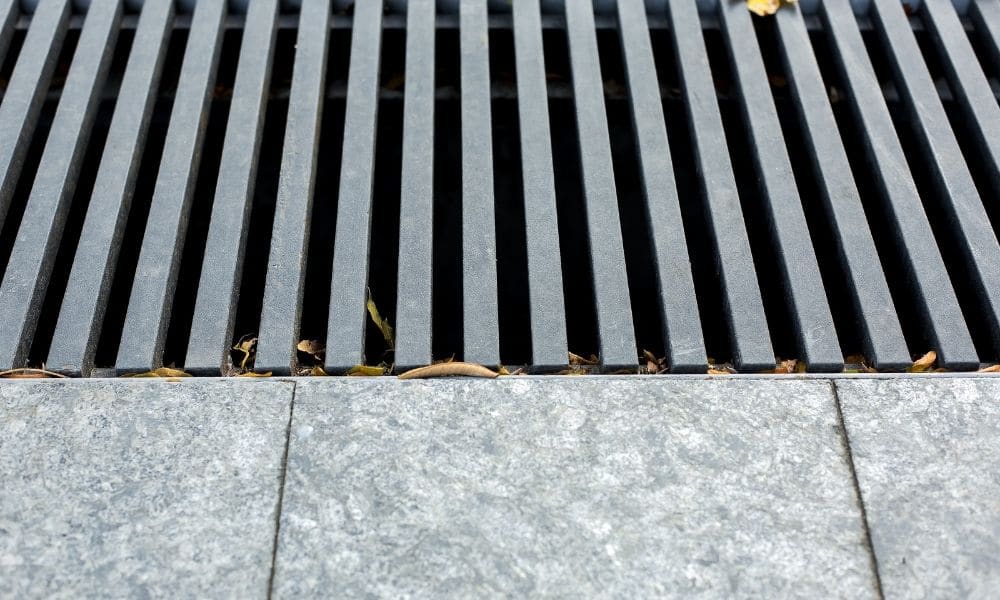
For many businesses and commercial properties, improper drainage of surface water is not only costly but also a time-consuming mess. Replace old systems that no longer work well or install the proper trench drain system from the beginning to avoid problems and loss of money. Let’s look at how to choose and install the right trench drain system for your commercial property needs.
What Is a Trench Drain System?
A trench drain system is an elongated drainage system used to remove excess surface water from an area, by use of a drainage channel, covered with a grate. They are placed just below the ground and come in several different styles and materials.
The Different Types of Trench Drains
There are two common types of trench drain systems: pre-cast and cast in place. Let’s take a look at each one.
Pre-cast
Pre-cast trench drains are formed using concrete. The term “pre-cast” stems from the fact that they’re premade in a factory, rather than onsite when installing drainage systems. This is done using metal molds which have predetermined measurements of width, height, and depth.
The benefit of a pre-cast concrete trench drain is that the entire process of creating the trench drain is done under perfectly controlled climate conditions. That means curing time is not only better as far as temperature, but also because the concrete is allowed the time it needs to cure properly, forming a stronger trench drain. Another benefit is because the trench is made in advance. Any special additions needed, such as coloring, are done during the process when manufactured.
A downside, however, is the fact that pre-cast means the concrete trench drain requires transportation to where it needs to lay. The additional need to transport the trench brings another cost as well as the risk of transporting concrete material. Several joints are often required to make a large trench drain moveable. In addition, materials and machinery necessary for moving each piece are needed on the site of which installation occurs.
ABT offers polymer concrete pre-cast trench drains which are created using additional binding and strengthening material, and have even more strength than cement alone, along with greater resistance to chemicals and a higher thermal stability rate.
Cast in Place
Cast-in-place trench drains are also made using concrete. However, unlike pre-cast drains, they are created on site. The trench is dug, then using forms and reinforcing bars, the concrete is poured, and when dry, all forms are removed. Cast-in-place trenches are labor intensive onsite, due to everything being done on the spot. They are, however, very accurate since they are poured onsite.
Unlike pre-cast trench drains, cast in place offers little variation or special requests. They also don’t require joints, have no transportation needs, and cut down on the need for machinery to lift and place the trench where it needs to go.
Because weather is uncontrollable, it plays quite a large role in determining when a cast-in-place trench drain system is poured. Curing of concrete takes time to reach its full strength. Temperature, humidity, and precipitation all affect the curing process.
Both cast in place and pre-cast concrete trench drains are very strong, durable, and reliable. A commercial property can expect a lifetime of use from concrete trench drains.
Applications
There are several applications of how commercial trench drains are used. Here’s a list of possible places a trench drain system is helpful on a commercial property:
- Warehouses — loading areas, water for cleaning machinery and floors, as well as storage containers filled with liquids all create a need for the drainage of run-off water.
- Parking lots — excess rainwater, flash floods, and melting snow have nowhere to go without proper drainage.
- Roadways — trench drains are used to control excess surface water and keep travelers safe.
- Commercial buildings — apartment complexes, shopping centers, and business buildings all need protection from excess surface water due to rain and flooding.
- Factories — Similar to a warehouse, a factory must control drainage of water and possible chemical spills.
Any commercial property can use a trench drain system in order to guard itself from the damage of excess water and liquids. Proactive, preventative measures always save a company money in the long run. Damages without protection in place are almost always more costly and time consuming.
The Role of the Grate
Once installed, the trench drain is covered with a grate. Grates protect the trench from accumulating large objects and debris, and they also protect vehicles, bikes, and pedestrians from walking or rolling into a trench drain. Grates must meet the required load class needed, just as the trench itself does. There are several different options for grates. Let’s look at what those are:
- Cast iron — by far the most popular because of its strength, cast iron is used just about anywhere because of what it can handle and how it holds up.
- Ductile iron — similar to cast iron and very strong.
- Stainless steel perforated — more often used for decorative purposes, stainless steel perforated is steel punched with designs for a pleasant aesthetic look.
- Galvanized steel – coated with zinc to prevent rust.
As mentioned, grates are chosen not only for appearance but also for their strength and safety features. Everything is taken into consideration, including who will walk near the great and what type of machinery will be around it or possibly applying pressure to it every day.
In this article we covered the most common commercial trench drain applications and materials. If you’re a commercial property owner considering a trench drain system, or are in the business of installing commercial trench drain systems, ABT has your solutions for commercial trench drain systems. We know how to choose and install the right trench drain system for your specific needs. Our Polydrain systems, formed with high-grade polyester resin, are the strongest out there. Contact ABT and let’s find the right drainage system for your needs.